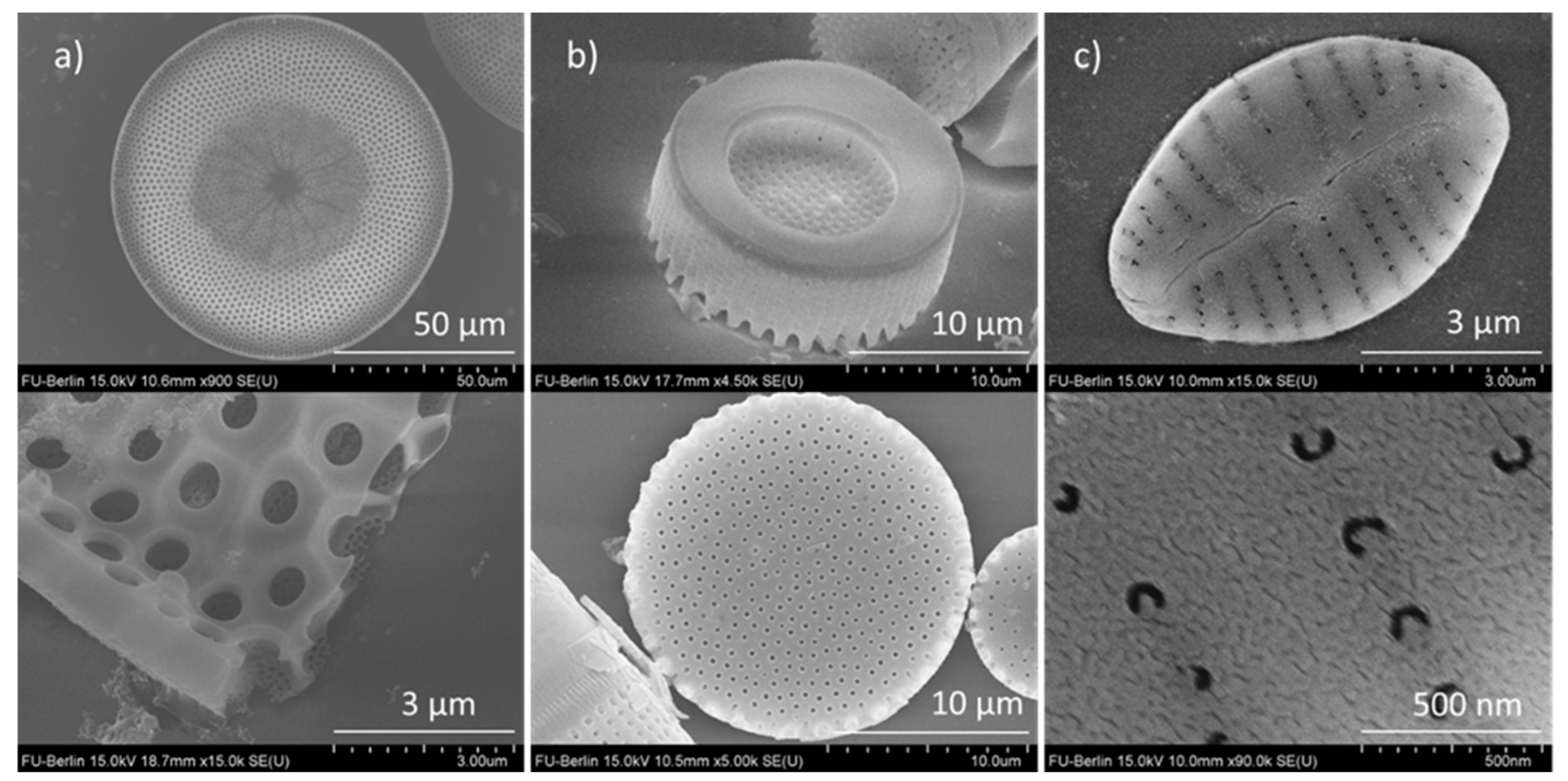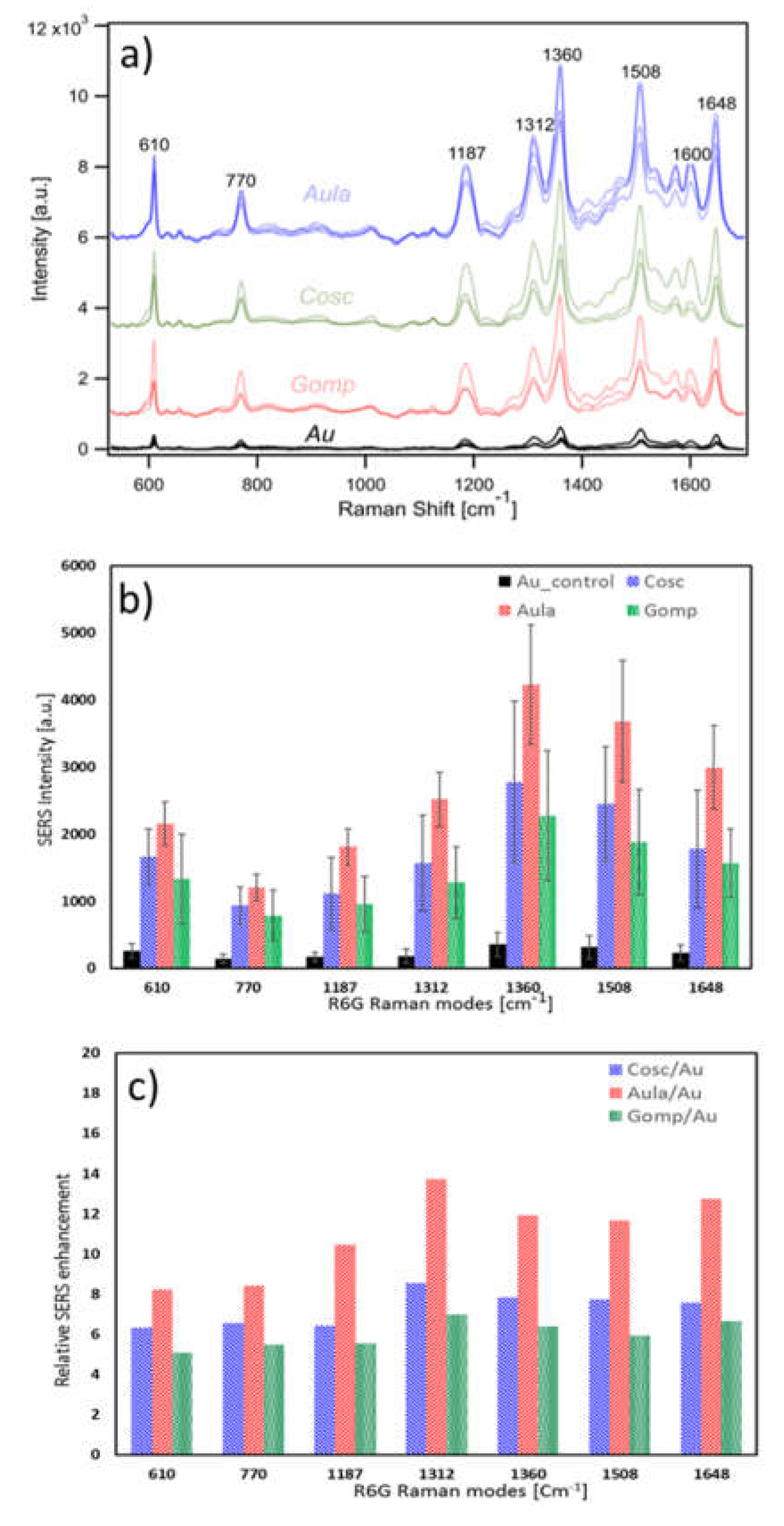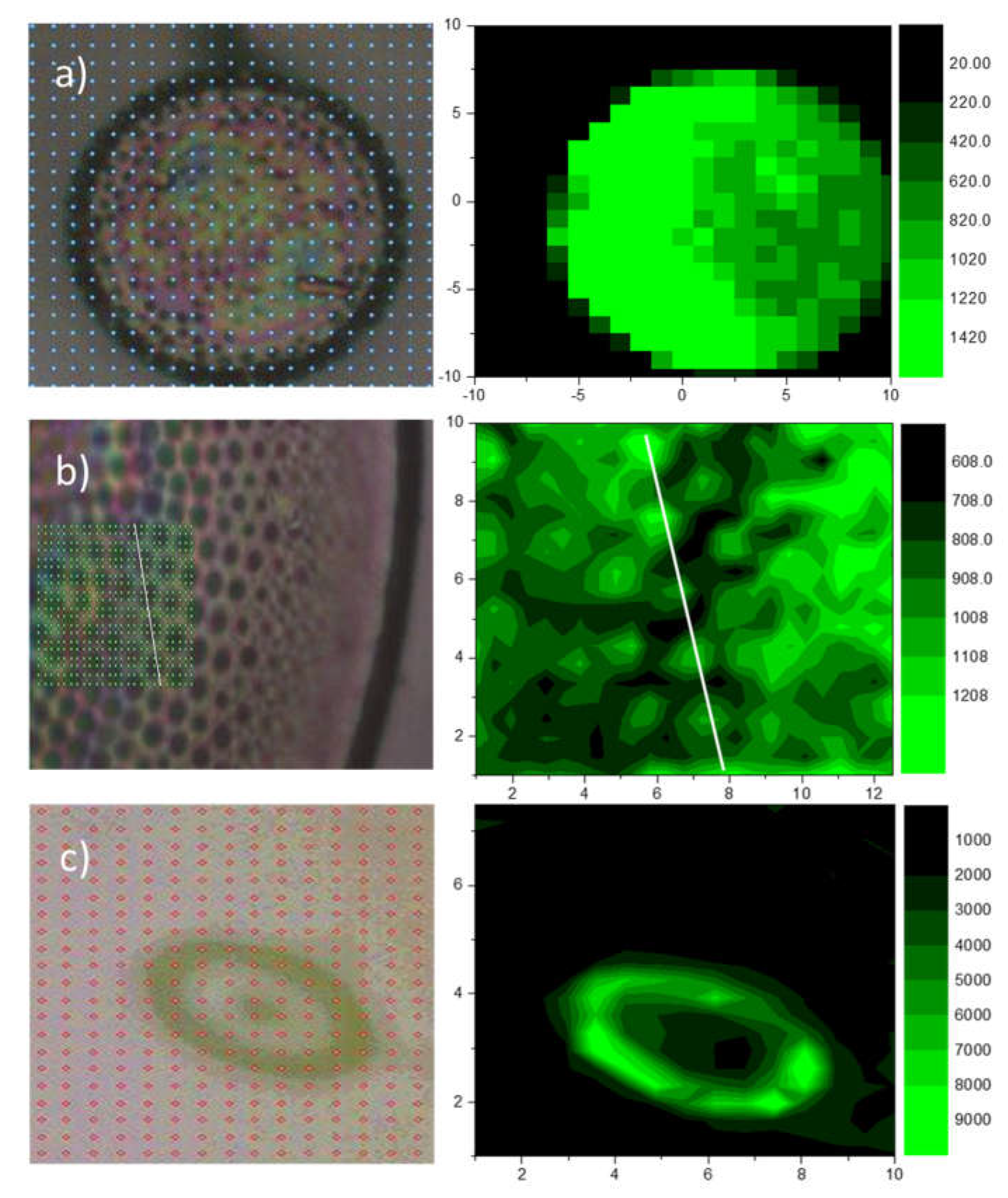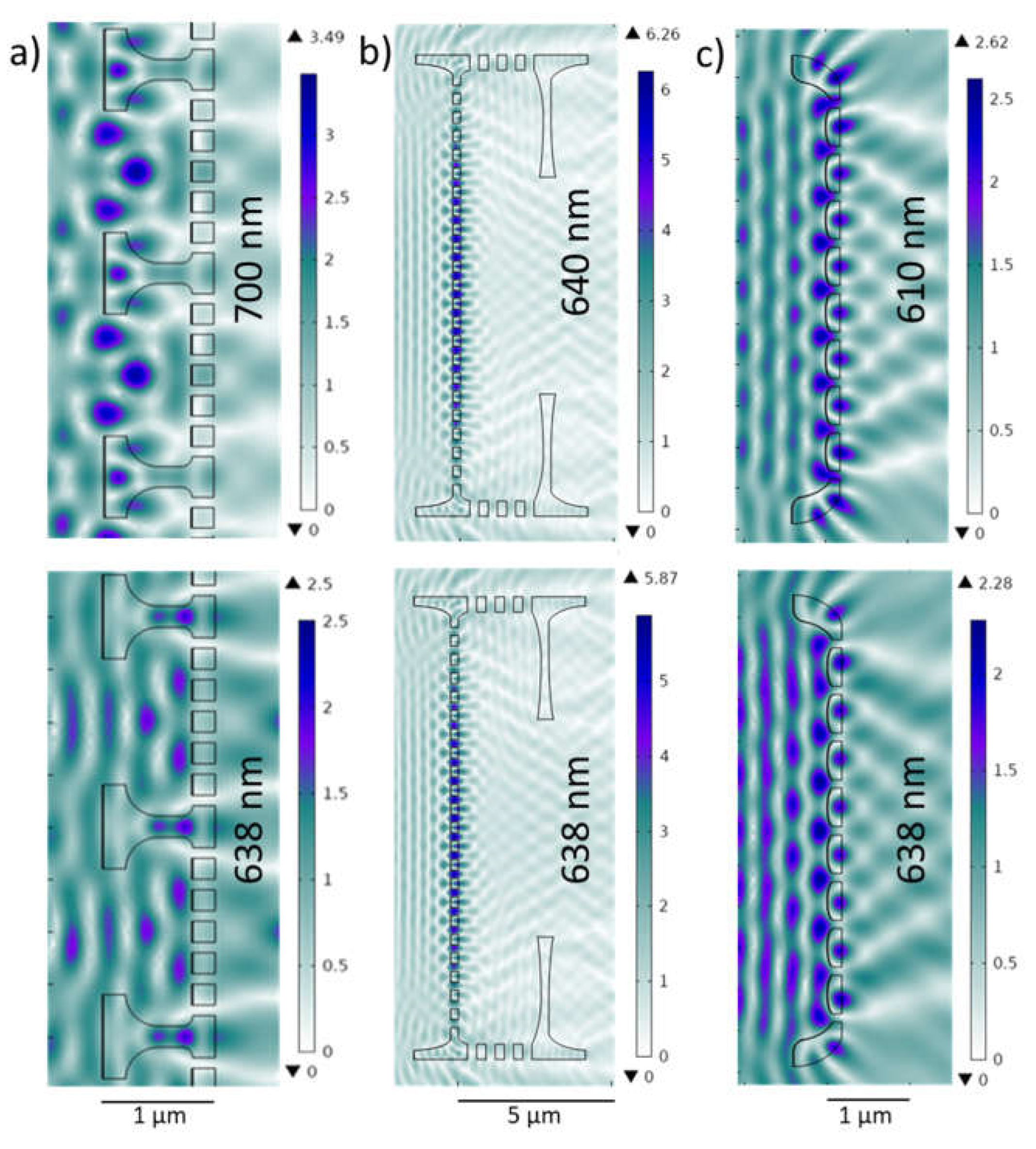Submitted:
18 April 2023
Posted:
19 April 2023
You are already at the latest version
Abstract

Keywords:
1. Introduction
2. Materials and Methods
2.1. Hybrid substrate preparation
2.2. Characterization
2.3. Numerical analysis
3. Results
3.1. Morphology and ultrastructure of the hybrid substrates
3.2. SERS enhancement over different substrates
3.3. Numerical analysis
4. Discussion
5. Conclusions
Supplementary Materials
Author Contributions
Funding
Data Availability Statement
Conflicts of Interest
References
- Fleischmann, M.; Hendra, P.J.; McQuillan, A.J. Raman Spectra of Pyridine Adsorbed at a Silver Electrode. Chem Phys Lett 1974, 26, 163–166. [Google Scholar] [CrossRef]
- Langer, J.; Jimenez de Aberasturi, D.; Aizpurua, J.; Alvarez-Puebla, R.A.; Auguié, B.; Baumberg, J.J.; Bazan, G.C.; Bell, S.E.J.; Boisen, A.; Brolo, A.G.; et al. Present and Future of Surface-Enhanced Raman Scattering. ACS Nano 2020, 14, 28–117. [Google Scholar] [CrossRef]
- Moskovits, M. Surface-Enhanced Raman Spectroscopy: A Brief Retrospective. Journal of Raman Spectroscopy 2005, 36, 485–496. [Google Scholar] [CrossRef]
- Wang, A.; Kong, X. Review of Recent Progress of Plasmonic Materials and Nano-Structures for Surface-Enhanced Raman Scattering. Materials 2015, 8, 3024–3052. [Google Scholar] [CrossRef] [PubMed]
- Hu, M.; Fattal, D.; Li, J.; Li, X.; Li, Z.; Williams, R.S. Optical Properties of Sub-Wavelength Dielectric Gratings and Their Application for Surface-Enhanced Raman Scattering. Applied Physics A 2011, 105, 261–266. [Google Scholar] [CrossRef]
- Chen, Y.-M.; Pekdemir, S.; Bilican, I.; Koc-Bilican, B.; Cakmak, B.; Ali, A.; Zang, L.-S.; Onses, M.S.; Kaya, M. Production of Natural Chitin Film from Pupal Shell of Moth: Fabrication of Plasmonic Surfaces for SERS-Based Sensing Applications. Carbohydr Polym 2021, 262, 117909. [Google Scholar] [CrossRef]
- Wang, Y.; Wang, M.; Sun, X.; Shi, G.; Zhang, J.; Ma, W.; Ren, L. Grating-like SERS Substrate with Tunable Gaps Based on Nanorough Ag Nanoislands/Moth Wing Scale Arrays for Quantitative Detection of Cypermethrin. Opt Express 2018, 26, 22168. [Google Scholar] [CrossRef]
- Zang, L.-S.; Chen, Y.-M.; Koc-Bilican, B.; Bilican, I.; Sakir, M.; Wait, J.; Çolak, A.; Karaduman, T.; Ceylan, A.; Ali, A.; et al. From Bio-Waste to Biomaterials: The Eggshells of Chinese Oak Silkworm as Templates for SERS-Active Surfaces. Chemical Engineering Journal 2021, 426, 131874. [Google Scholar] [CrossRef]
- Shi, G.C.; Wang, M.L.; Zhu, Y.Y.; Shen, L.; Ma, W.L.; Wang, Y.H.; Li, R.F. Dragonfly Wing Decorated by Gold Nanoislands as Flexible and Stable Substrates for Surface-Enhanced Raman Scattering (SERS). Sci Rep 2018, 8, 6916. [Google Scholar] [CrossRef]
- Tian, L.; Jiang, Q.; Liu, K.-K.; Luan, J.; Naik, R.R.; Singamaneni, S. Bacterial Nanocellulose-Based Flexible Surface Enhanced Raman Scattering Substrate. Adv Mater Interfaces 2016, 3, 1600214. [Google Scholar] [CrossRef]
- de Tommasi, E.; de Luca, A.C. Diatom Biosilica in Plasmonics: Applications in Sensing, Diagnostics and Therapeutics [Invited]. Biomed Opt Express 2022, 13, 3080. [Google Scholar] [CrossRef] [PubMed]
- Round, F.E.; Crawford, R.M.; Mann, D.G. Diatoms: Biology and Morphology of the Genera; Cambridge university press, 1990; ISBN 0521363187.
- Fuhrmann, T.; Landwehr, S.; el Rharbi-Kucki, M.; Sumper, M. Diatoms as Living Photonic Crystals. Applied Physics B 2004, 78, 257–260. [Google Scholar] [CrossRef]
- Ghobara, M.M.; Ghobara, M.M.; Mazumder, N.; Vinayak, V.; Reissig, L.; Gebeshuber, I.C.; Tiffany, M.A.; Gordon, R.; Gordon, R. On Light and Diatoms: A Photonics and Photobiology Review. In Diatoms: Fundamentals and Applications; Wiley, 2019; pp. 129–189.
- Ghobara, M.M.; Ghobara, M.M.; Ghobara, M.M.; Mohamed, A. Diatomite in Use: Nature, Modifications, Commercial Applications and Prospective Trends. In Diatoms: Fundamentals and Applications; Wiley, 2019; pp. 471–509.
- Wang, Y.; Cai, J.; Jiang, Y.; Jiang, X.; Zhang, D. Preparation of Biosilica Structures from Frustules of Diatoms and Their Applications: Current State and Perspectives. Appl Microbiol Biotechnol 2013, 97, 453–460. [Google Scholar] [CrossRef]
- Ghobara, M.M.; Gordon, R.; Reissig, L. The Mesopores of Raphid Pennate Diatoms: Toward Natural Controllable Anisotropic Mesoporous Silica Microparticles; 2021.
- De Tommasi, E. Light Manipulation by Single Cells: The Case of Diatoms. Journal of Spectroscopy 2016, 2016, 1–13. [Google Scholar] [CrossRef]
- Perozziello, G.; Candeloro, P.; Coluccio, M.; Das, G.; Rocca, L.; Pullano, S.; Fiorillo, A.; De Stefano, M.; Di Fabrizio, E. Nature Inspired Plasmonic Structures: Influence of Structural Characteristics on Sensing Capability. Applied Sciences 2018, 8, 668. [Google Scholar] [CrossRef]
- Zhang, M.; Meng, J.; Wang, D.; Tang, Q.; Chen, T.; Rong, S.; Liu, J.; Wu, Y. Biomimetic Synthesis of Hierarchical 3D Ag Butterfly Wing Scale Arrays/Graphene Composites as Ultrasensitive SERS Substrates for Efficient Trace Chemical Detection. J Mater Chem C Mater 2018, 6, 1933–1943. [Google Scholar] [CrossRef]
- Ren, F.; Campbell, J.; Wang, X.; Rorrer, G.L.; Wang, A.X. Enhancing Surface Plasmon Resonances of Metallic Nanoparticles by Diatom Biosilica. Opt Express 2013, 21, 15308. [Google Scholar] [CrossRef]
- Managò, S.; Zito, G.; Rogato, A.; Casalino, M.; Esposito, E.; de Luca, A.C.; de Tommasi, E. Bioderived Three-Dimensional Hierarchical Nanostructures as Efficient Surface-Enhanced Raman Scattering Substrates for Cell Membrane Probing. ACS Appl Mater Interfaces 2018, 10, 12406–12416. [Google Scholar] [CrossRef]
- Kwon, S.Y.; Park, S.; Nichols, W.T. Self-Assembled Diatom Substrates with Plasmonic Functionality. Journal of the Korean Physical Society 2014, 64, 1179–1184. [Google Scholar] [CrossRef]
- Kim, K.; Shin, D.; Kim, K.L.; Shin, K.S. Electromagnetic Field Enhancement in the Gap between Two Au Nanoparticles: The Size of Hot Site Probed by Surface-Enhanced Raman Scattering. Physical Chemistry Chemical Physics 2010, 12, 3747. [Google Scholar] [CrossRef]
- Ghobara, M.; Oschatz, C.; Fratzl, P.; Reissig, L. Numerical Analysis of the Light Modulation by the Frustule of Gomphonema Parvulum: The Role of Integrated Optical Components. Nanomaterials 2022, 13, 113. [Google Scholar] [CrossRef] [PubMed]
- Jensen, L.; Schatz, G.C. Resonance Raman Scattering of Rhodamine 6G as Calculated Using Time-Dependent Density Functional Theory. J Phys Chem A 2006, 110, 5973–5977. [Google Scholar] [CrossRef] [PubMed]
- Sakai, M.; Ohmori, T.; Fujii, M. Two-Color Picosecond Time-Resolved Infrared Super-Resolution Microscopy. In; 2007; pp. 189–195.
- Lindon, J. Encyclopedia of Spectroscopy and Spectrometry; 2nd ed.; 2010.
- He, X.N.; Gao, Y.; Mahjouri-Samani, M.; Black, P.N.; Allen, J.; Mitchell, M.; Xiong, W.; Zhou, Y.S.; Jiang, L.; Lu, Y.F. Surface-Enhanced Raman Spectroscopy Using Gold-Coated Horizontally Aligned Carbon Nanotubes. Nanotechnology 2012, 23, 205702. [Google Scholar] [CrossRef] [PubMed]
- Sil, S.; Kuhar, N.; Acharya, S.; Umapathy, S. Is Chemically Synthesized Graphene ‘Really’ a Unique Substrate for SERS and Fluorescence Quenching? Sci Rep 2013, 3, 3336. [Google Scholar] [CrossRef]
- Stec, H.M.; Williams, R.J.; Jones, T.S.; Hatton, R.A. Ultrathin Transparent Au Electrodes for Organic Photovoltaics Fabricated Using a Mixed Mono-Molecular Nucleation Layer. Adv Funct Mater 2011, 21, 1709–1716. [Google Scholar] [CrossRef]
- Kossoy, A.; Merk, V.; Simakov, D.; Leosson, K.; Kéna-Cohen, S.; Maier, S.A. Optical and Structural Properties of Ultra-Thin Gold Films. Adv Opt Mater 2015, 3, 71–77. [Google Scholar] [CrossRef]
- Ghobara, M.M.; Tiffany, M.A.; Gordon, R.; Reissig, L. Diatom Pore Arrays’ Periodicities and Symmetries in the Euclidean Plane: Nature Between Perfection and Imperfection. In Diatom Morphogenesis; Wiley, 2021; pp. 117–158.
- Wang, S.S.; Magnusson, R. Theory and Applications of Guided-Mode Resonance Filters; 1993.
- Wang, S.S.; Magnusson, R.; Bagby, J.S.; Moharam, M.G. Guided-Mode Resonances in Planar Dielectric-Layer Diffraction Gratings; 1990; Vol. 7.
- Collin, S. Nanostructure Arrays in Free-Space: Optical Properties and Applications. Reports on Progress in Physics 2014, 77. [Google Scholar] [CrossRef]
- Yang, J.; Ren, F.; Chong, X.; Fan, D.; Chakravarty, S.; Wang, Z.; Chen, R.; Wang, A. Guided-Mode Resonance Grating with Self-Assembled Silver Nanoparticles for Surface-Enhanced Raman Scattering Spectroscopy. Photonics 2014, 1, 380–389. [Google Scholar] [CrossRef]
- Kraai, J.A.; Wang, A.X.; Rorrer, G.L. Photonic Crystal Enhanced SERS Detection of Analytes Separated by Ultrathin Layer Chromatography Using a Diatom Frustule Monolayer. Adv Mater Interfaces 2020, 7, 2000191. [Google Scholar] [CrossRef]
- D’Mello, Y.; Bernal, S.; Petrescu, D.; Skoric, J.; Andrews, M.; Plant, D. V. Solar Energy Harvesting Mechanisms of the Frustules of Nitzschia Filiformis Diatoms. Opt Mater Express 2022, 12, 4665. [Google Scholar] [CrossRef]





Disclaimer/Publisher’s Note: The statements, opinions and data contained in all publications are solely those of the individual author(s) and contributor(s) and not of MDPI and/or the editor(s). MDPI and/or the editor(s) disclaim responsibility for any injury to people or property resulting from any ideas, methods, instructions or products referred to in the content. |
© 2023 by the authors. Licensee MDPI, Basel, Switzerland. This article is an open access article distributed under the terms and conditions of the Creative Commons Attribution (CC BY) license (http://creativecommons.org/licenses/by/4.0/).



